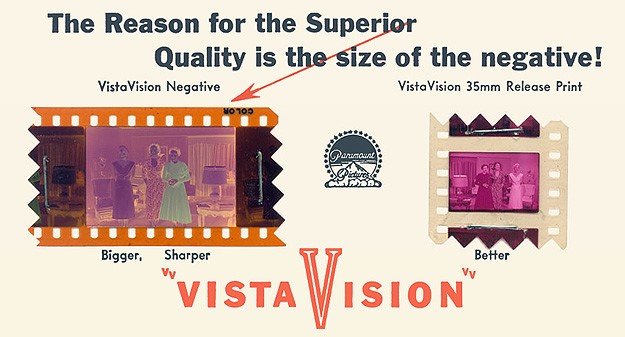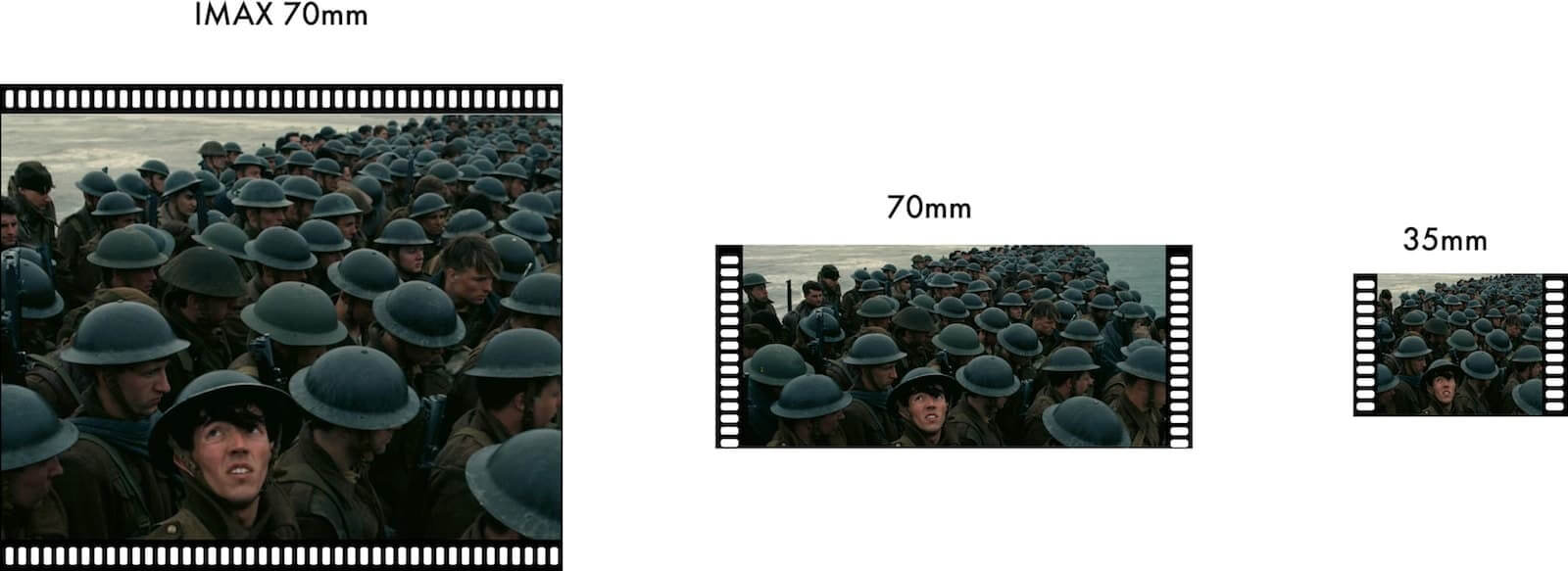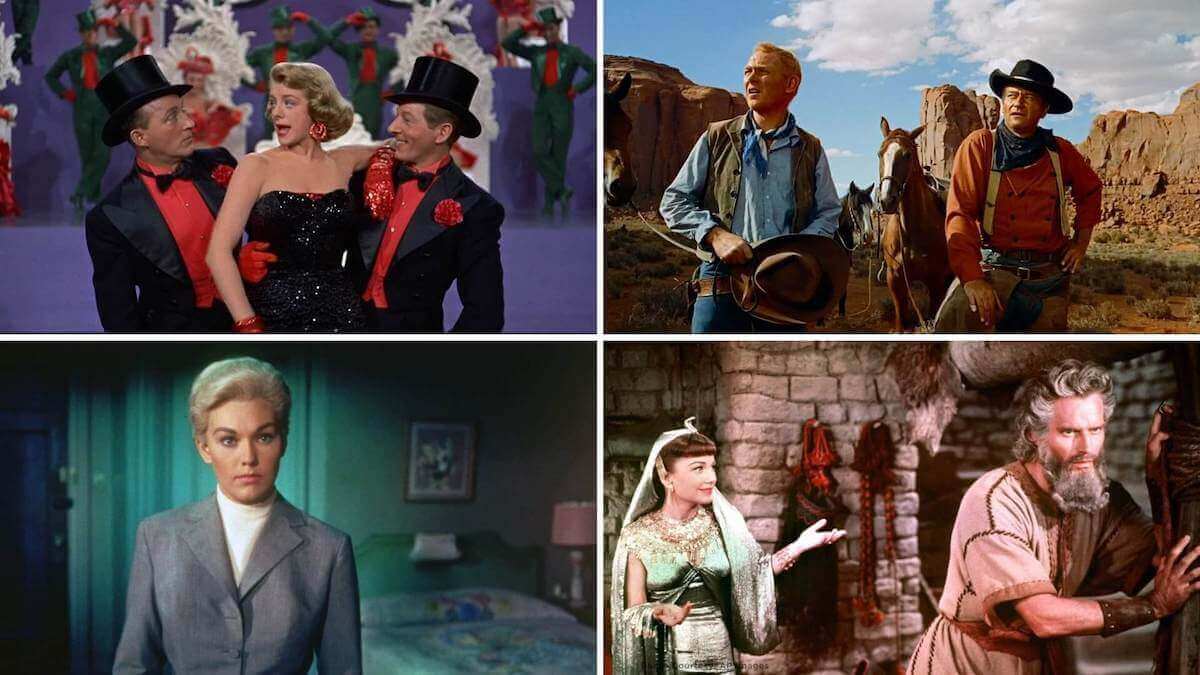Before the 1950s, nearly every single movie was in the same 4:3 aspect ratio. But then CinemaScope from 20th Century Fox changed the landscape with widescreen imagery to get people into theaters nationwide. Pretty soon, other studios were making their own widescreen movies, including Paramount Pictures with VistaVision. What is VistaVision, you ask? Well, it takes a bit of explaining, so if you can, please join us as we look into the origins of VistaVision, what it was like, and why it still matters today.
VistaVision Camera
The origins of Vista Vision
There is plenty we can talk about when it comes to the VistaVision aspect ratio, so let’s first start with a definition and information about its characteristics.
VISTAVISION DEFINITION
What is VistaVision?
VistaVision is a high-resolution widescreen process that uses 35mm film. Unlike most other types of filmmaking, the VistaVision camera process involves turning the film stock on its side, so that the perforations are at the top and bottom of the image (instead of on the left and right). This allows for an image space 2x the size of traditional 35mm. Resulting in higher-resolution photography, along with a native widescreen VistaVision aspect ratio of about 1.5:1 that can, by design, be cropped for 1.66:1, 1.85:1, and 2:1.
VistaVision camera characteristics include:
- Widescreen presentation.
- High-resolution imagery.
- Paramount Vista Vision logo at the beginning (only for Paramount films that used the process).
VistaVision was created in 1954 by Paramount Pictures engineers, as a format to compete with CinemaScope and other studios. Paramount had actually released their first widescreen movie by cropping the Western film Shane (1953) from its 1.37:1 Academy Ratio to 1.66:1. This was just on regular 35mm, but it gave the studio the idea for what would become Vista Vision.
What is VistaVision? • Paramount promo film
In comparison to CinemaScope’s anamorphic lenses, VistaVision was a “flat” widescreen process, which meant filmmakers and theaters did not need special VistaVision lenses to shoot or present Vista Vision movies.
Filmmakers did, however, need a special VistaVision camera that could shoot the film horizontally. While this process is behind why the image quality was so good, it also meant that the film stock would run out twice as fast.

What is VistaVision? • VistaVision aspect ratio
When providing prints for theaters, nothing special was required, as the movies would be copied onto regular 35mm film that could be shown at any theater that had a widescreen (which, by 1954, was most of them). In addition to the movies not having the distortion of anamorphic, VistaVision provided an option for filmmakers and theaters that wanted a widescreen experience that didn’t sacrifice height or width and could be easily presented nationwide.
Vista Vision Movies
The rise and fall of Vista Vision
The first of the VistaVision films was White Christmas (1954), and it was a wild success. It was also one of the few VistaVision films that had 8-perforation prints made for special engagements that could present the movies in their original format (horizontal VistaVision prints vs regular vertical 35mm).
This required special equipment that most theaters were not going to house, especially since it was impractical and prone to problems.
But Paramount was not trying to make Vista Vision movies that could only be screened in select theaters. The VistaVision camera was meant to provide an easy widescreen process that emphasized quality above all else, while still making that quality accessible to as many movie goers as possible.
And it accomplished that, with movies like 3 Ring Circus (1954), Richard III (1955), The Ten Commandments (1956), The Searchers (1956), Funny Face (1957), and many others.
What is VistaVision? • Martin Scorcese on Richard III
One of the most famous directors to make VistaVision films is Alfred Hitchock, who used it for To Catch a Thief (1955), The Man Who Knew Too Much (1956), Vertigo (1958), and North by Northwest (1959), the latter of which was released by MGM, an uncommon example of VistaVision being licensed out to another studio.
However, the good times were not to last. Marlon Brando’s only directorial effort, One-Eyed Jacks (1961), was the last of the VistaVision films Paramount Pictures produced. The format fell out of favor soon after the early ‘60s, primarily due to advancements in film stock and processes from other companies that made VistaVision obsolete.
New film formats were coming out around this time and filmmakers had new ways to shoot their movies without having to rely on movie studios.
Related Posts
VistaVision Lenses
The legacy of Vista Vision
Since VistaVision was no longer a major format, Paramount sold off many of their cameras to international filmmakers, who used the process infrequently throughout the rest of the decade. Many of these “off-brand” VistaVision films included classics of Japanese cinema, such as Death by Hanging (1968), In the Realm of the Senses (1976), and Vengeance is Mine (1979).
However, VistaVision caught a true second wind during the New Hollywood era of the 1970s. A group of young filmmakers wanted to use the format to film visual effects shots in their upcoming science-fantasy movie.
These filmmakers made their own rigging and came up with some creative ways to use the camera for VFX purposes.
What is VistaVision? • Star Wars revolutionizing VFX
These filmmakers were, of course, working on Star Wars (1977), which, more or less, changed cinema for the rest of the century. It also proved that VistaVision could still be used for VFX shots, since the larger negative space provided less film grain when compositing the effects shots.
As a result of the Star Wars franchise (as VistaVision was also used on both The Empire Strikes Back and Return of the Jedi), more movies started to use the film format for VFX purposes.
These included the first two Star Trek movies, the Back to the Future trilogy, the first two Men in Black and Mummy films, the first two Sam Raimi Spider-Man films, and Christopher Nolan’s Dark Knight trilogy. The Dark Knight (2008) specifically used a VistaVision shot during the truck-flipping sequence.
What is VistaVision? • The Dark Knight
Speaking of Nolan, VistaVision movies also ended up being a precursor to large-format filmmaking, which is most comparable with the creation of IMAX. IMAX shoots and presents their movies horizontally, much like VistaVision movies did. IMAX also emphasizes height over width (just like VistaVision).
In addition to using much larger film stock than other 70mm productions, IMAX made a name for itself by producing high quality motion pictures that could only be shown in select cinemas (unlike VistaVision).

What is VistaVision? • VistaVision and IMAX
VistaVision demonstrated a want for widescreen cinema that put quality and immersion ahead of width and theatricality. IMAX and VistaVision may not be exactly the same, but it does show that the pursuit for this type of filmmaking did not die with the end of the format.
If anything, it increased that pursuit, as can also be seen in how the cameras were used for high quality VFX work. It may be a relic of a bygone era, but like CinemaScope, its influence can still be felt today.
UP NEXT
How does IMAX work?
Now that you know more about VistaVision, learn about IMAX, how it came to be, and how it revolutionized cinema. We provide examples of new and old movies that have used the popular large-format medium, including such recent hits like Avengers: Infinity War and Endgame.
Up Next: IMAX explained →
Showcase your vision with elegant shot lists and storyboards.
Create robust and customizable shot lists. Upload images to make storyboards and slideshows.
